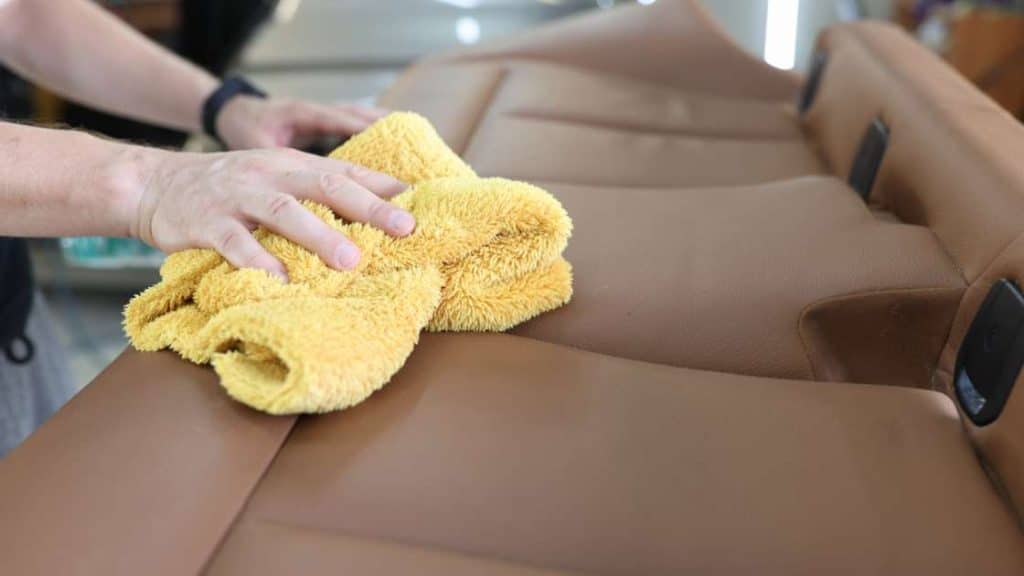To clean microfiber chair seats, vacuum the fabric and gently rub stains with a damp, soapy cloth. Avoid excessive water and use a dry brush to restore the texture after cleaning.
Maintaining the pristine condition of microfiber chair seats can be hassle-free when you know the appropriate cleaning techniques. Microfiber, known for its durability and stain resistance, is a popular choice for furniture. Despite its resilience, thoughtful care is necessary to extend the life of your microfiber seats.

Maintaining the pristine appearance of your microfiber chair seats is essential for long-lasting comfort and visual appeal. To achieve this, Insight into how to clean microfiber chair seats is vital.
In the upcoming paragraphs, I’ll provide you with practical and proven steps to ensure your chairs stay free from dust, spills, and wear and tear, preserving their inviting look and feel.
Introduction To Microfiber Furniture
Microfiber furniture, known for its durability and stain resistance, is a popular choice for home interiors. Properly cleaning microfiber chair seats ensures they maintain their sleek look and comforting texture, safeguarding your investment.
Imagine sinking into a cozy chair that feels like a warm hug. That’s the comfort microfiber furniture offers. Microfiber, a synthetic fabric, is a favorite in homes for its durability and soft texture.

The Popularity Of Microfiber
Many choose microfiber for their furniture because it combines luxury with practicality. Its popularity lies in its fine threads, which create a surface that’s both plush and smooth.
What makes microfiber a top choice for many?
- Resilience: It stands up to daily wear and tear.
- Easy to clean: Most spills can be wiped away.
- Price: More affordable than many natural fabrics.
- Look: It has the appearance of suede or leather.
Benefits And Challenges Of Microfiber Chair Seats
| Benefits | Challenges |
|---|---|
| Stain resistant: Doesn’t absorb liquids quickly. Low maintenance: Simple care routine. Hypoallergenic: Doesn’t hold onto allergens. | Static cling: May attract dust and lint. Sensitivity: Harsh chemicals can damage it. Water spots: Requires careful cleaning methods. |
Why care for microfiber? Proper maintenance keeps it looking fresh. Although resilient, mishandling can lead to lasting damage. Using the right cleaning techniques is key.
Before You Begin: Identifying Your Microfiber
Cleaning microfiber chair seats starts with knowing what you’re working with. Each type has its own care requirements. Identifying the microfiber type is essential. This ensures the right cleaning method. This will help maintain the chair’s look and feel.
Decoding Microfiber Cleaning Codes
Check the tag on your microfiber furniture. You’ll find a vital cleaning code. Here’s what each code means:
| Code | Meaning |
|---|---|
| W | Water-based cleaners are okay to use. |
| S | Solvent-based cleaners are the right choice. |
| S-W | Both water-based and solvent-based cleaners are safe. |
| X | No water, no solvent, just a vacuum is needed. |
Following these codes prevents damage. It keeps cleaning safe for your chair’s specific fabric.
Testing For Colorfastness
Before cleaning your chair, perform a colorfastness test. Choose an inconspicuous area. Dab with a damp white cloth. Check for color transfer.
- If there’s a color on the cloth, use caution. Your chair may not be colorfast.
- No color on the cloth? You can proceed with cleaning.
Taking these steps preserves the integrity and appearance of your furniture. With this knowledge, you’re ready to begin the cleaning process.
Getting Started: Pre-cleaning Preparations
When it’s time to refresh your microfiber chair seats, starting with the right pre-cleaning steps is essential. Proper preparation ensures a smooth cleaning process and helps you avoid any damage to the delicate fabric. Before diving into the main cleaning task, let’s focus on the initial stages to set the groundwork for a spotless outcome.
Gathering Your Cleaning Supplies
Selecting suitable cleaning materials is essential for microfiber chairs. Using the wrong items can damage the fabric. Gather supplies beforehand to streamline the cleaning process.
Vacuum cleaner with upholstery attachment

Soft-bristled brush or microfiber cloth

Mild detergent or specialized microfiber cleaner

Distilled water, to prevent water spots

White vinegar or rubbing alcohol for tougher stains

Spray bottle, for easy application

Keep these items within reach before starting. They will help you tackle many types of dirt and stains effectively.
Removing Surface Debris And Dust
Clearing loose particles is the first step to a deeper clean. Microfiber can trap dust and crumbs easily. Here’s how to prep your chair for a thorough cleansing:
- Remove pillows or cushions from the chair.
- Use a vacuum cleaner with an upholstery attachment to gently suck up dirt.
- For nooks and crannies, use a soft-bristled brush to loosen debris.
- After vacuuming, go over with a lint roller for any remaining particles.
This will make the next steps of wet cleaning more efficient and help protect the fabric’s integrity. Once the dry dirt is lifted, your microfiber seats are ready for stain removal and deeper cleaning.
Spot Cleaning Microfiber Seats
Keeping microfiber chair seats looking fresh is a must for a neat home. Spot cleaning is a quick fix for accidental spills and stains. Let’s drop into how to tackle these mishaps with ease.
Addressing Spills Immediately
Time is of the essence when dealing with any spill. Absorb as much liquid as possible with a clean cloth. Avoid rubbing; simply blot the spill. This prevents the spill from spreading and setting into the fabric.
Choosing The Right Cleaning Agents
Microfiber needs special care. Determine the type of microfiber by checking the tag. ‘W’ means water-based cleaners are safe. ‘S’ indicates a need for a solvent-based cleaner. And ‘S-W’ says either could work.
- For ‘W’ fabric, mix warm water with a bit of dish soap.
- For ‘S’ fabric, use rubbing alcohol or a dry-cleaning solvent.
- Test cleaners in an inconspicuous spot first.
Apply the chosen cleaner to a clean cloth. Gently dab the stained area without soaking the fabric. Use a soft-bristled brush to revive the microfiber once dry.
Using Water-based Cleaning Techniques
Clean microfiber chair seats easily with water-based solutions. These gentle, effective methods are safe for most chairs. Say goodbye to stains and hello to a fresh, clean look.
Diy Water-based Cleaning Solutions
Create your cleaner for microfiber seats. Mix simple ingredients from home. Always patch test on a hidden area first. Here’s a recipe:
- Dish Soap: Combine warm water with a few drops.
- Vinegar: Add equal parts with water for tougher stains.
- Baking Soda: Sprinkle over the surface, then dampen with a vinegar spray.
Bold Tip: Use a spray bottle to apply your mixture lightly.
Methodology For Water-based Stain Removal
- Blot the Stain: Use a white cloth to avoid color transfer.
- Apply Cleaner: Spray your DIY solution onto the cloth. Gently dab on the stain.
- Soft Brush: Gently scrub with a soft-bristled brush to loosen dirt.
- Rinse Cloth: Use a clean, damp cloth to rinse the area. No soaking.
- Dry: Pat with a dry cloth. Let air dry fully or use a fan.
Remember: Never oversaturate. Microfiber dries quickly with less water.
Applying Solvent-based Cleaning Methods
Embracing the right technique is vital for the upkeep of microfiber chair seats. Solvent-based cleaning methods can tackle stubborn stains on microfiber. Identifying when and how to apply these methods ensures the safety and longevity of your furniture.
When To Use A Solvent-based Cleaner
Some situations call for solvent-based cleaners:
- Greasy stains: When water-based cleaners falter on oil or wax-based spots.
- Stubborn marks: Stains that resist soap and water may need a solvent.
- Dry-only fabric: Labels indicating ‘S’ or ‘X’ suggest solvent-only cleaning.
Safe Application Of Solvents On Microfiber
Follow these steps to safely use solvents:
- Test first: Apply on a small concealed area to check for colorfastness.
- Ventilation is key: Open windows to prevent fume build-up.
- Use sparingly: Dampen a cloth with solvent; avoid soaking the fabric.
- Blot, don’t rub: Gently press against the stain to lift it without spreading.
- Air dry: Let the chair seat dry naturally; avoid heat sources that can damage microfiber.
Deep Cleaning For Tough Stains
Sometimes, a light dusting just won’t cut it. Your microfiber chair seats witness spills, spots, and life’s little messes. For those tenacious stains that seem to cling on, a deep cleaning routine becomes necessary. With the right approach and some homemade solutions, those stubborn marks will be history.
Homemade Clean Mixtures
Before reaching for expensive cleaners, consider whipping up your effective mixtures. These not only save money but are also gentle on your fabrics. Check the manufacturer’s label to ensure compatibility.
Here are a couple of go-to mixtures:
- Soap Solution: Mix a teaspoon of dishwashing liquid in a cup of warm water.
- Vinegar Mix: Combine equal parts white vinegar and water.
Step-by-step Process For Deep Cleaning
Follow these simple steps for a thorough cleaning:
- Blot: Start by blotting the stain with a clean, dry cloth.
- Apply: Dampen a sponge with your chosen mixture and gently rub.
- Dab: Use another cloth to absorb the moisture.
- Brush: Once dry, fluff up the fibers with a soft-bristle brush.
Remember to always do a spot test in an inconspicuous area first. Allow the chair to fully dry before using it again.
Drying And Fluffing Post-cleaning

Cleaning microfiber chair seats leaves them fresh and spotless. Proper drying and fluffing are essential next steps. These methods ensure the seat is comfortable and looks great.
Proper Drying Techniques
Never rush the drying process of microfiber. High heat damages the material. Follow these steps:
- Blot excess water with a clean towel.
- Let the chair air-dry naturally.
- Avoid direct sunlight to prevent fading.
- Use a fan to circulate air if needed.
Restoring The Fluffiness Of Microfiber
A soft, fluffy chair invites relaxation. Restore your microfiber to its original state:
- Gently brush the fabric once dry.
- Use a soft-bristled brush to lift fibers.
- Move in a circular motion for even fluffiness.
| Step | Action | Tool |
|---|---|---|
| 1 | Brush Lightly | Soft Brush |
| 2 | Lift Fibers | Soft-Bristled Brush |
| 3 | Even out Surface | Hand Movements |
Repeat brushing weekly to maintain softness and fluffiness.
Preventive Maintenance Of Microfiber Chair Seats

Maintaining microfiber chair seats starts with prevention. Regularly caring for your chairs can keep them looking like new. Let’s explore simple yet effective ways to keep those seats in top condition.
Routine Upkeep Tips
- Vacuum frequently to remove dust and loose particles.
- Use a soft brush to gently lift dirt and maintain the fabric’s nap.
- Blot spills immediately with a clean cloth to prevent stains.
- Dry brushing can handle light soiling without moisture.
Protective Measures To Prolong Cleanliness
Improve your microfiber chair’s longevity with these tips:
| Method | Benefit |
|---|---|
| Throw Blankets | Shield seats from spills and wear |
| Arm Covers | Minimize oils and dirt from skin contact |
| No Pets Policy | Avoid claws and fur-related damage |
Common Mistakes To Avoid While Cleaning Microfiber
Cleaning microfiber chair seats requires special care. Without the right technique, the fabric can be easily damaged. This section highlights the errors many people make. Avoid these to keep your microfiber furniture in top shape.
Missteps That Can Damage Microfiber
- Using the wrong cleaning products: Harsh chemicals can ruin microfiber. Opt for mild detergent or specialized cleaners.
- Excessive water usage: Too much water causes stains and damage. Use a damp cloth instead of soaking the fabric.
- Scrubbing aggressively: Rough handling can crush microfiber’s texture. Gentle motions preserve the integrity.
- Ignoring care labels: Each microfiber type has specific needs. Always check the manufacturer’s instructions.
- Applying heat: High temperatures can melt microfiber. Avoid using hot water or hair dryers on the seats.
How To Correct Cleaning Blunders
- Act quickly on stains: Blot fresh spills immediately. Prevents deep fiber penetration.
- Test cleaning agents: Apply a small amount on an inconspicuous area first. Ensures compatibility and safety.
- Use a soft brush: Gently loosen the dirt. Maintains fabric surface.
- Pat dry the area: After cleaning, use a dry, absorbent towel. Helps avoid watermarks.
- Readjust fibers: Once dry, use a soft-bristled brush. Restores the seat’s soft feel.
Adopt smart cleaning practices to ensure the longevity of microfiber chair seats. These dos and don’ts safeguard the material against accidental damage. Always treat microfiber with care for the best results.
Professional Cleaning Services Vs. Diy
Tackling microfiber chair stains can spark a dilemma: to tackle them alone or call in experts? Both options have merits. Crafting an effective strategy requires differences. This write-up delves into Professional Cleaning Services vs. DIY for microfiber chair seats, helping readers make an informed decision.
When To Call Professional Cleaners
Intense stains or odors on microfiber chairs signal it’s time for professional help. High-traffic environments like offices or dining areas benefit from expert cleaning services. Pros bring advanced equipment and techniques that guarantee a deep clean.
Consider professionals when encountering:
- Stubborn stains that household remedies can’t solve.
- Persistent odors even after regular cleaning.
- Allergies triggered by unseen chair contaminants.
- Limited time or desire to tackle the cleaning yourself.
Assessing The Diy Approach Versus Professional Care
The necessities for each cleaning approach prove essential. DIY methods can be effective for lighter stains and regular maintenance. They often involve common household items and require minimal expertise.
| DIY Cleaning | Professional Cleaning |
|---|---|
| Cost-effective | More costly but thorough |
| Day-to-day upkeep | Suitable for deep cleaning |
| Easy-to-find cleaning agents | Specialized products and equipment |
| Time and effort required | Time-saving with professional handling |
A DIY approach hinges on your confidence and skill level. If dealing with simple spills or light soiling, home methods could suffice. Yet, a thorough job from professionals extends the life of your chairs and ensures a sanitary environment.
Enjoying Your Freshly Cleaned Microfiber Seats
As you admire the pristine finish on your microfiber chair seats, remember the simple steps that brought you here. Knowing how to maintain this inviting gleam not only ensures a longer life for your furniture but also keeps your living space welcoming and immaculate.
Review Of Best Practices
- Vacuum regularly to remove dust and debris.
- Use a soft bristle brush to loosen stubborn dirt.
- Mild detergent and water are often enough for most spills.
- Test cleaning products on an inconspicuous spot first.
- Blot, don’t rub when cleaning up spills to avoid pushing the stain deeper.
- Air-dry seats fully to prevent moisture damage.
The Satisfaction Of A Clean And Inviting Space
Clean furniture brightens any room and invites relaxation. Your microfiber chair seats now not only feel good to the touch but also improve the entire area. This freshness reflects your care for your home and the comfort you offer to guests.
Hold the cleanliness, knowing that proper care will keep these seats looking and feeling great for years. Friends and family will enjoy the comfort and beauty of your spotless furniture, making every gathering more enjoyable.
Frequently Asked Questions For How To Clean Microfiber Chair Seats
Can Vinegar Clean Microfiber Chair Seats?
Yes, a vinegar solution can effectively clean microfiber chair seats. Mix equal parts of white vinegar and water, spray lightly on the stained area, and gently blot with a soft cloth to remove stains without damaging the fabric.
What’s The Best Way To Dry Microfiber Seats?
The best way to dry microfiber seats after cleaning is to let them air dry. Avoid direct heat or sunlight, which can harm the fabric. You can also use a hairdryer in a cool setting if you need to speed up the process.
Are Microfiber Seats Machine Washable?
Some microfiber chair cushions with removable covers are machine washable. Check the manufacturer’s instructions. If washable, use a gentle cycle with cold water and mild detergent, then air dry to prevent shrinkage or damage.
How Often Should I Clean Microfiber Chair Seats?
For routine maintenance, clean microfiber chair seats every few months. If spills or stains occur, clean them promptly to prevent them from setting. Regular vacuuming is also recommended to remove dust and debris.
Is microfiber easy to clean?
Yes, microfiber is generally easy to clean as it is a synthetic material that repels liquid and resists stains. Cleaning usually involves a simple process of wiping or blotting with a damp cloth, making it a convenient choice for many households.
Is microfiber good for furniture?
Microfiber is an excellent choice for furniture due to its durability, stain resistance, and easy maintenance. Its tightly woven fibers make it resistant to spills and stains, while its soft texture adds comfort, making it a practical and stylish option for upholstery.
Conclusion
Cleaning microfiber chair seats need not be daunting. With the right techniques and gentle products, you’ll ace this task. Remember, quick action on spills is key to avoiding stains. Hold routine care to keep your chairs looking fresh and spotless.
Happy cleaning and enjoy your rejuvenated furniture!

